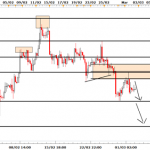In this article, I will review the recent statement made by Fed chair Janet Yellen about the possibility for rate hikes in 2017 and the latest ISM Non-Manufacturing report. The rate hike in March appears to be locked in. I am surprised with the speed at which the market changed what it was pricing in. There have been some good survey reports, but nothing dramatically new since mid-February when the market didn’t expect a rate hike. I think this was a case of the market’s initial expectations being wrong and it correcting itself. I said if the Fed wanted to make March a ‘live’ meeting, it would need to act aggressively in changing the market’s perception as the odds in mid-February were showing about a 20% chance of a rate hike. The Fed made that change which is why the market reacted the way it did. I was wrong in my prediction that no rate hike would occur. The ISM Non-Manufacturing data is one example of a great survey report which may have helped move the needle towards an accelerated rate hike schedule.
Before I delve into Yellen’s speech and the ISM report, I would like to review the recent occurrence where the VIX has been coupling with the S&P 500. Usually the VIX and the S&P 500 are the inverse of each other, but sometimes for short periods of time they act in tune. This may be because of trades which have gone rogue such as a hedge fund that is forced to liquidate its position because of poor performance.
The chart below shows the previous times the VIX and the S&P 500 have had a relatively high correlation. As you can see, the current correlation is the highest it has been in the past two years. The previous times when the VIX and the S&P 500 were relatively correlated, a correction in the S&P 500 followed soon afterwards. I have made the point that either the S&P 500 was going to fall or the VIX would fall. Unlike the previous times they were correlated, this time the VIX corrected instead of the S&P 500. Today, the VIX fell 7.20% while the S&P 500 was only up 0.05%. The VIX made up for the recent rally it had by falling back down to earth. Considering the fact that there has been 98 days without a 1% fall in the S&P 500, the VIX should be near its all-time low; it’s now at 10.96.
















Leave A Comment